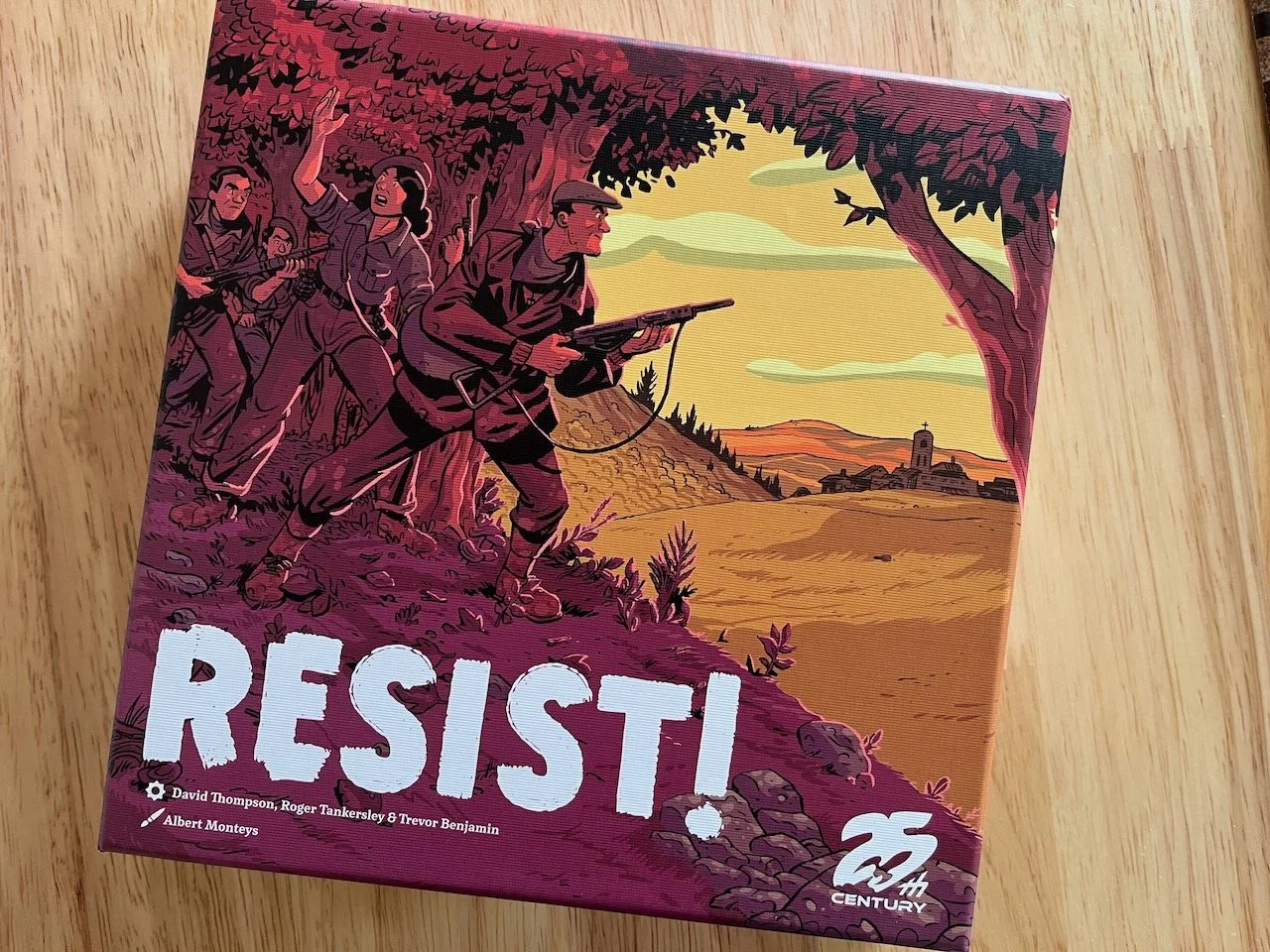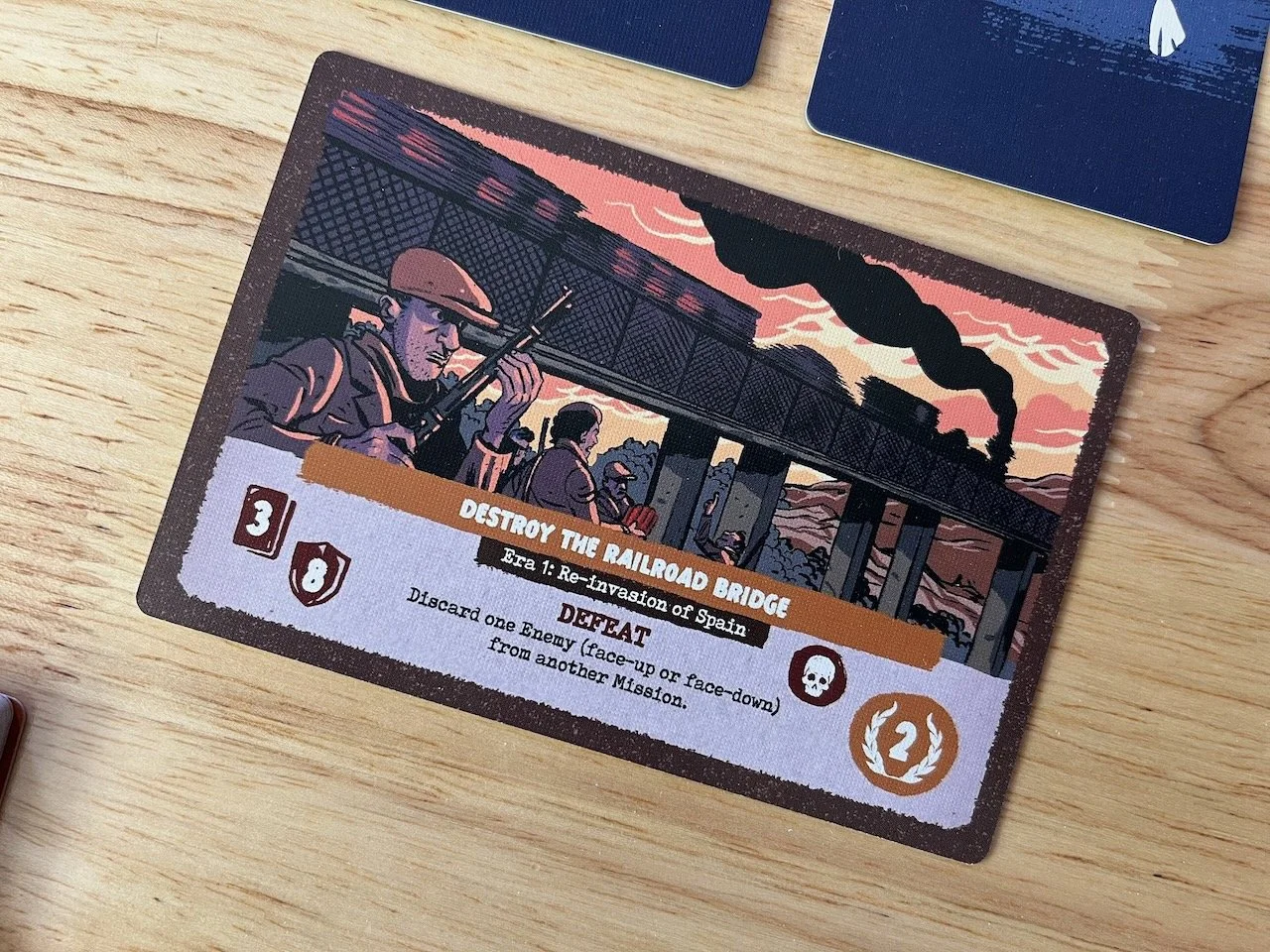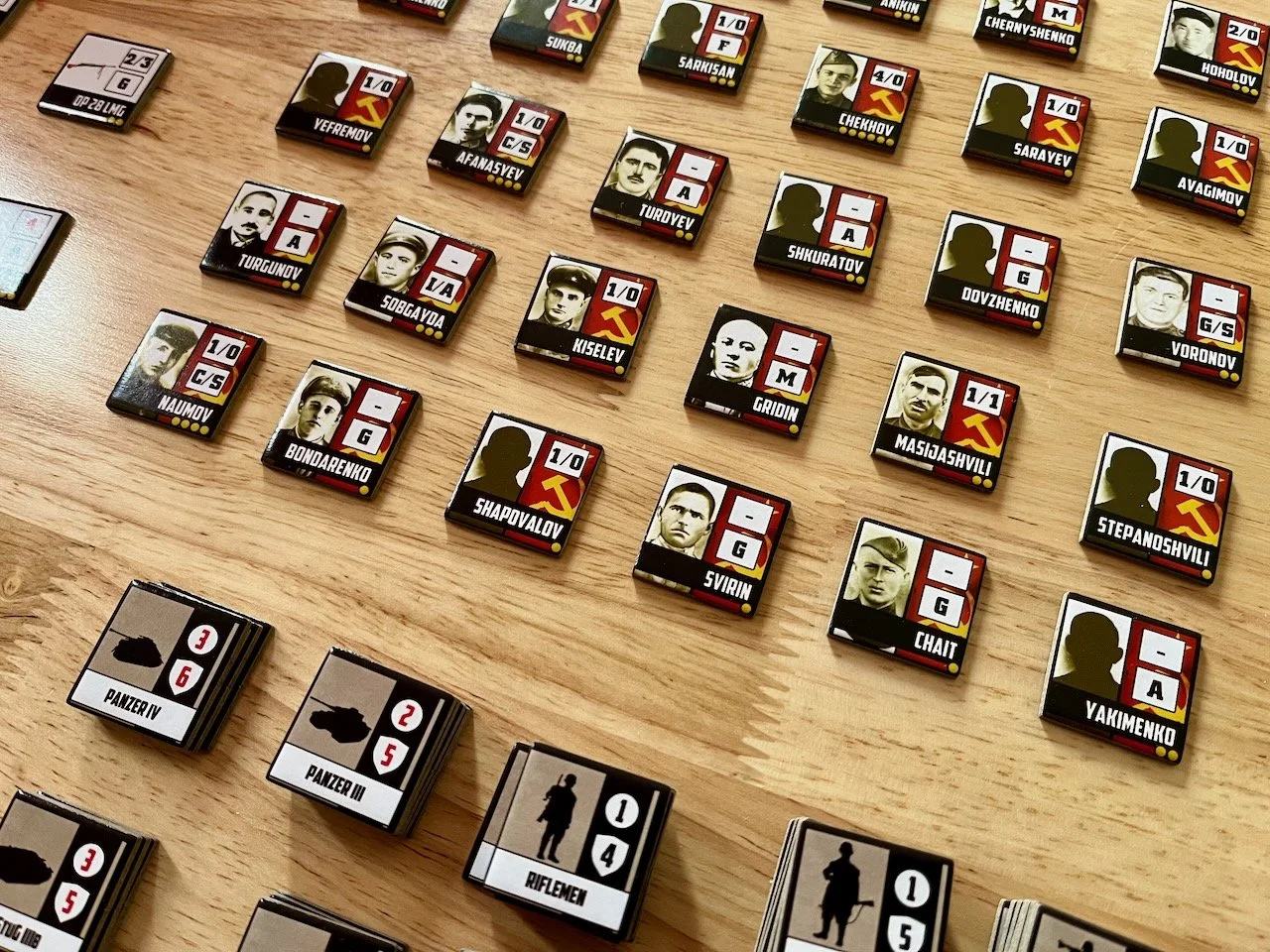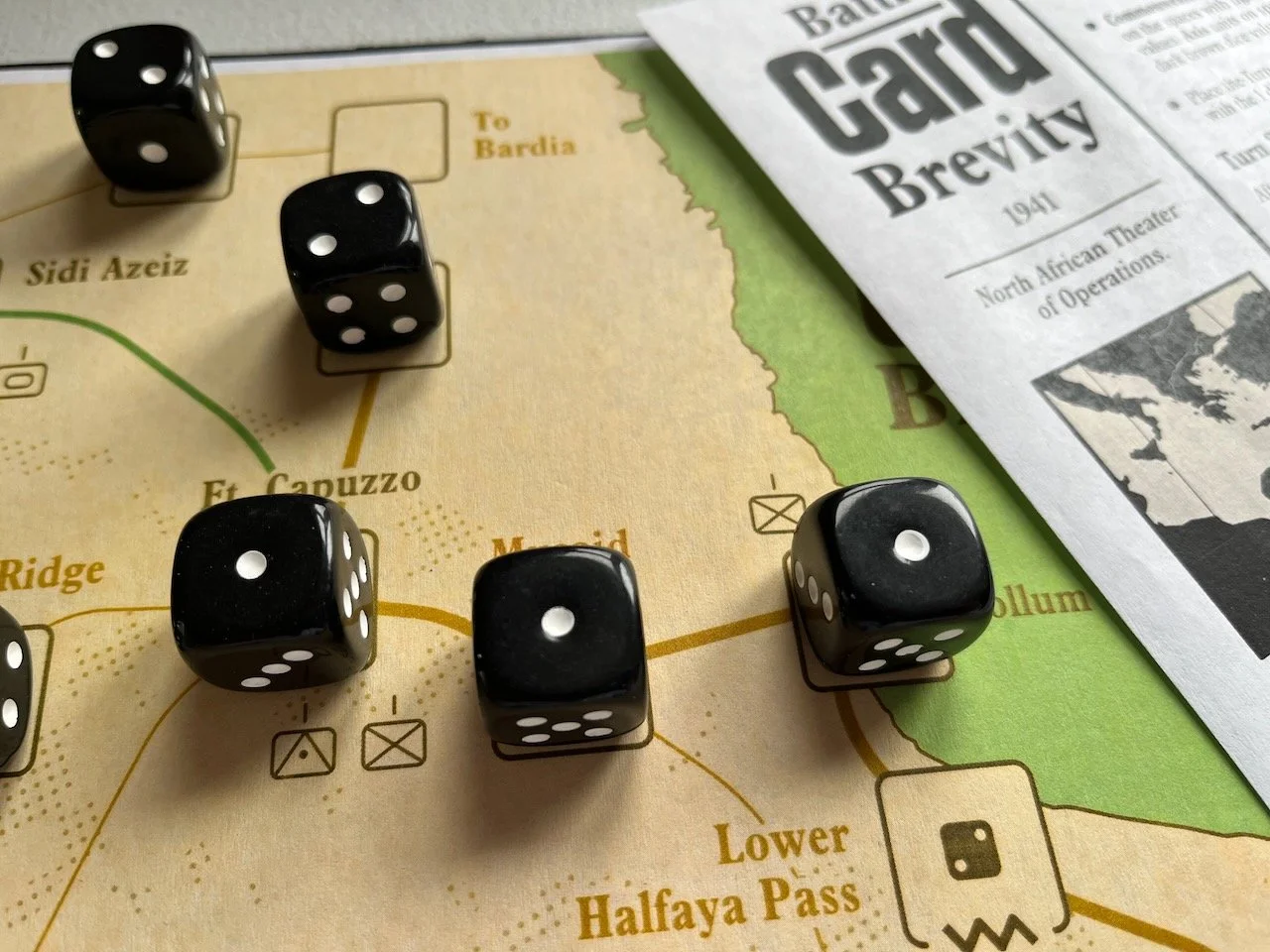Resist!, Pavlov’s House and Battle Card: David Thompson Invades My Game Table
This is adapted from the script of Episode 101: Resist! First Play Caps off a Very David Thompson Summer”
I messaged board game designer David Thompson on BoardGameGeek this May when I was getting my teeth into Pavlov’s House, one of his many hit designs: “I kid you not,” I told him, “I bailed on a dinner party Saturday before the ‘dinner' part because I wanted to come home and run it again. Got an Order of the Red Banner, so I feel I made the right decision. Dinner is boring and Pavlov's House is awesome.”
I distinctly remember the decision point. I was in the kitchen of an acquaintance who was throwing himself an intimate going away party. There was an outgoing kid there who asked me if I liked to read. Something about the way I phrased my answer got him on a pep talk about the value of literacy. He told me that reading more is easier if you just start by reading a little bit every day.
Right about the time he suggested places to find used Stephen King books, a golden bolt shot all through me: “I gotta get the fuck outta here.” I was Starkville bound inside two minutes. I got home, set up the board again and ran it ’til I dropped.
A lot of Thompson’s work crept onto my table without my planning it that way. You know how you become aware of a movie director or record producer in hindsight because you keep seeing the same name in the credits of your favorite stuff? It’s like that.
This is the story about how this house became a David Thompson house in 2025, in the context of a handful of titles: Resist!, Pavlov’s House and Battle Card.
Resist! First Impressions: Looks pretty now, wait until you have to start burning your fighters to get stuff done, you’re gonna cry
I was obsessed with Resist! from the moment I read about it on Space-Biff’s blog when Salt & Pepper Games debuted it about three years ago. In 2022 I was making friends with the fact that I’d be playing more games without friends if I wanted to stop being bitter and find a new way to access the beauty of a game spread out on a table. Resist! looked like a beautiful way to do that.
Between his work with the Valiant Defense series and solo designs for Salt & Pepper Games, it seems like Thompson likes a good underdog story to give gameplay extra juice. Here he — along with co-designers Trevor Benjamin and Roger Tankersley — gave solo players a chance to reignite a chapter of the fierce and doomed attempts to undo General Francisco Franco’s 1930s military coup in Spain, which set off a three-year civil war.
This subject matter ignited thrilling neural pathways: strains of The Clash’s “Spanish Bombs,” memories of a book I read about the making of Picasso’s Guernica, scenes from Hemingway’s For Whom the Bell Tolls and Orwell’s Homage to Catalonia.
Resist! is set during a war, but like 2015’s The Grizzled, isn’t centered on the mechanics of shoot, move, maneuver. Resist! abstracts all that and instead sets you before a poignant series of keenly dangerous roster management and target selection puzzles, whose actors and targets are rendered in the dusky mauves and rusts of Spanish illustrator Albert Monteys’ pens and inks. On top of all the other rich associations, it looks like I also have the opportunity to dive into the frame of a Tintin adventure.
My fighters are Spanish maquis who fled to southern France during the civil war, acquired sabotage and guerrilla warfare skills during the German occupation, then snuck back into Spain to fuck with General Franco’s tradfash regime even after his military officially won the civil war.
I carried a lot with me to my first play. Resist! hit my mailbox right at the end of a vicious three-day sick that stole one of September’s sweetest golden weeks from me. I was emotionally grated. My whole self was a raw nerve when I got this to the table: What the hell was I doing, trying to take comfort in playpen resistance in a rural memory of a town just a few miles south of the Ludlow, where the resistors met the guns of the Colorado militia and the Baldwin-Felts Detective Agency and got shot at and burned up without one demand being met? My skin ached. My heart was brittle and angry.
But I kept on because I still wanted into this story and its system. I’ve noticed that, within the mechanical loop of what you’re asked to do on a turn, a different world — similar to and evocative of its real-life source but imbued with its own sustaining, hermetic inertia — emerges alongside and within the formal confines of game. Playing with yourself is not resistance. But it can provide moments of transcendence. It created a space where I could work with my little cartoon guerrilla fighters.
I still felt like bawling when I had to sacrifice Ricardo on the first mission. If there’s one mechanic that not only provides the most emotion and challenge — juxtaposing the game’s world and its tantalizing offer of organized resistance against the creeping takeover of the AI-Silicon Valley-Pentagon panopticon — it’s the dilemma at the heart of it: You’re commanding guerrillas who must strike and melt away if they don’t want to get hunted down. Or get half the people in the village where they get supplies lined up and shot.
The operatives at your disposal are Sagrario, Ricardo, Anastasio, Manuel and 20 others, each of which have a two-sided card. One shows what they can get done while preserving their cover. The other side of their card is much more powerful, but Franco’s spies and security forces are going to know who they are if you use that ability.
Turn one, it looked like I'd be able to blow up the target bridge, but Ricardo — one of the four sent out for the job — was gonna get his fingernails torn out by the secret police or something. How many maquis prayed while huddling in some mountain cave that a blown operative was lucky enough to get shot in action rather than finish their time tied to a chair somewhere, coughing up teeth and secrets?
Resist! Era 1 Mission: I thought I was pretty badass when I was tearing through these assignments, then I realized I’d burned too many fighters while flexing over the rubble of my early-game accomplishments
The game strategy that tips this seesaw of consequences is more subtle than I just suggested. Your maquis cards do more than sneak, snip, wire, bomb and ambush: Some of their effects help bring new members into the group, ferret out spies, boost other cards, and deliver intel on target locales.
There’s more than one kind of tradeoff to weigh, especially when you consider there are up to four missions in play at once, each of which has its own garrison of enemy cards on the lookout for your fuckery: Engineers, grunts, spymasters, and soldiers are on high alert at each barracks or bridge you want to attack — and each unit type triggers effects that either make your attack more risky or result in bloody reprisal on your operatives and local civilians if you don’t have enough firepower to take Franco’s spies and soldiers down. The first time I saw how much there was to think about on a mission, I just froze.
But it was my first play, so I freed myself of calculating all the angles for the initial raids and focused on the steps of the turns, which were velvety smooth because the rulebook is excellent. I stormed a series of level one missions in high style, launching big raids that wiped out the garrisons and smashed the targets.
Which was a tremendous lark until the harder missions started rolling out and I realized I’d lost too many maquis, there were more spies diluting my roster, and I was in deep trouble. Antonio, Manuel, Manuela, Juana, Anastasio, Sagrario, Soledad and Marcelino had already been captured, killed or gone to ground somewhere.
My last turn of the night consisted only of drumming the table with my fingers, exhaling loudly through my nose, staring back and forth between my hand and the missions, looking for some magical seam through the midgame that wasn’t there. I only had three maquis at my disposal. I’d scouted two locations and the garrisons guarding each were pure murder. I was already looking at the end.
The end here can come a few different ways: If you fail two missions, get too many civilians killed, or your talent pool gets so infested with spies that you draw a whole handful of them, you trigger an immediate loss.
The win? That’s kind of up to you.
You can decide to deactivate your maquis and close out the resistance at the end of any turn if you decide your cadre of guerrillas is too diminished to continue without being wiped out altogether. Almost any solid effort will win you a forgiving Draw in the end-of-game win rating system, but the outcomes grade up from there all the way to the Epic Win, an ahistorical trophy where you actually succeed in toppling Franco.
A Draw is what I had to settle for my first time out. After a dinner break, I looked at the midgame situation again, took down one more target for pride, then had my plucky cartoon squad hang it up.
From a gameplay standpoint, I want more of this. The lucid setup diagram and game steps glide you right up that first few yards of trail, giving you just enough of a taste of action to want to scale up the well-guarded heights of the much meaner midgame. I want to explore the subtleties and power of the card effects, plus I’ve learned enough about the bastards who guard the targets to crave a second run at them. My read on this game since its release feels 100% dead on. This will get played more and reported on in the future.
Reflecting on my first game, I linger on the ache of something else fragile, beautiful, and necessary that Resist! serves up at the tender junction of the imaginative and the historical: The power of hidden places. The ability to melt away from the sweeping gaze of men who crave omniscience, both for themselves and to sell to the government. These kinds of spaces, even when they’re in the hands of a Bond villain on an island in a movie, have always intrigued me. They’re psychic, mythological and ecological counterweights, quasi-political wildnernesses of liberty and privacy that can never be wholly tamed, patrolled or surveilled.
No fascist dictator can gain or hold their position without the backing of the industrialists and financiers. Today is no different, except for the prominence and loudness of the digital-era moguls in that cohort — men whose businesses’ share price hinges on knowing everything while making nothing we really couldn’t do without if it were gone tomorrow. To hear them talk, the permanent closure of hidden space is not only something to be celebrated, it’s a fait accompli.
For them I reserve my favorite gypsy curse from the pages of For Whom the Bell Tolls: “I shit in the milk of the whores that birthed you.”
Pavlov’s House Replays: I like this game every bit as much as I did in May, but I wasn’t nearly as good as I imagined
Now let’s rewind to this spring and a different set of David Thompson underdogs: the soldiers of Pavlov’s House, named after the Russian sergeant who got handed the order to grab and keep an apartment building overlooking 9 January Square during the worst of the Stalingrad fighting in 1942.
Remember back at the beginning of the segment where I bragged to designer David Thompson about winning an Order of the Red Banner — a highly rated win — during my first series of games? I’m not so sure I did.
Or if I did, I sure can’t seem to recreate it after having it back on the table for three weeks in September. Does Pavlov’s House have replay value? Yes. Especially if you value humility.
Quick recap for those who missed Episode 91: Pavlov’s House is part of Dan Verssen Games’ Valiant Defense series — games where you step into pockets of WWII history when American, Russian, Polish and other nations’ fighters mounted legendary stands against vastly superior German forces.
Before I had to pack it up to work with Resist!, I was running a game every day or two for three weeks. It was my morning workout, my mental sparring partner, the whole time. And it punished me for my rusty skills.
The first gains in spring were the easiest, but I plateaued when I got it back out, losing my first four games as Stugs and Panzers barreled right through the walls. How could this be? In my May string of games, I was getting pretty good at one of the game’s most addictive features: Connecting decisions on the regimental part of the map with the tactical situation in the house. Keeping anti-aircraft cover up so you can string up those comms lines, keep your artillery support working, and get supplies, fresh legs, and combat engineers to spell the wounded and killed inside that death trap.
Except I kept getting overrun. What the hell happened?
One, my expectations were off. I anticipated the same rate of improvement I felt during the first few games, which any athlete or coach will tell you is an utter fantasy. Two, I had a few minor rules wrong. Three, I remembered a couple of my favorite tricks, but forgot all the subtle secondary decisions that made those gambits work at the streetfight level. There were also obvious strategies I’d never even considered.
The battle doctrine I adopted for Pavlov’s House was a lot like me: Too clever by half, vulnerable to disruption and prone to frequent meltdown. The surges of bad luck you experience in this game are frightful and require the long view if you’re going to avoid what I did one morning two weeks ago: I screamed “ROLL SOMETHING ELSE!” and hurled a German Stuka attack card across the living room.
I’d set it up right, placing an artillery spotter in the House to help blunt the late-game German onslaught. Everybody in that house was screaming at the spotter to call it in the thunder because there was a clanking tide of Panzers and machine gun teams bearing down on the west side of the house…and there was nobody on the other end of the radio because the Stukas pinpoint drilled my one working artillery site for the second turn a row. Plus my ack-ack bozos didn’t hit anything in the early game. Again.
These kinds of reversals are amusing, even cinematic, when you’re learning and infuriating when you’re done being amazed by theme and want to start mastering the system. You will simply not enjoy this unless you’re well conditioned to hosing your pals off the walls, taking a deep breath, and stoically doing the best you can with what’s left.
Don’t be mistaken: This game is my #1 solo addiction of the summer because of its dance of ups and downs — and for the variety of decisions it affords you with its balance of quick pace and manageable detail. Last summer it was Cascadia. Summer 2025 belonged to Pavlov’s House. When I’m willing to eat breakfast standing over the stove for the 10th straight time because I don’t want to take the game down…that’s your toast and your jam.
I’m still looking for that surge of simultaneous luck, agility, and tinkered approach that will vault one of my squads into the halls of wartime myth. Because after I do that, there are advanced variants I haven’t even touched and want to try, bad breaks and crashouts and all.
Battle Card Operation Brevity: You guys are so dead when I get to Ft. Capuzzo
Last week I picked up my Battle Card maps again and moved on to Operation Brevity, one of the Commonwealth’s pushes against the Axis early in the North African campaign.
Your job, general? Roll out of the desert in three major assault columns and start kicking overstretched Axis forces out of places like Halfaya Pass, Musaid, Fort Capuzzo and other key areas where British high command has figured the Italians or Germans will move if you give ‘em a good, hard shove.
In the real-life version of this campaign, this limited offensive was also supposed to set up a possible drive on the city of Tobruk, where Commonwealth forces were surrounded and still holding out, but Battle Card doesn’t ask the world of you: This is the first scenario I’ve tried in the series that gives you ranked victories or losses based on which locations you take, and at what cost.
There’s not a lot of head-scratching required to execute the plan: You attack and gun it through everything in your path…until your three major columns are abreast in Sollum, Musaid, Ft. Capuzzo or Hafid Ridge. Put it in neutral and have a look at that map, sir: Depending on how many men and tanks you lost getting there, Axis forces at Sidi Azeiz could bog you down in counterrattacks.
This is the thinkiest of the three I’ve played so far because of how the roads between objectives start to intersect and how limited time makes you weigh whether or not you can go for the Major Victory, a Minor Victory, or even take an L if one of the prongs on your offensive pitchfork break.
To put things in perspective: If you’re looking for a stiff challenge, see Resist! or Pavlov’s House. Most of these maps you can figure out how to crush in a few tries unless you are in some kind of vegetative state. But I ran Operation Brevity an extra four or five games because there seemed to be more wiggle in how your final push takes form in turns two, three and four.
While the challenge level remains easy, the variations from map to map are thoughtful and entertaining. I’ve still got Operation Eidelweiss and The Battle of Moro River to check out. Count on hearing about those in the future, because if nothing else, I’ll need to return to these in between games of Resist! so I can feel like a big, tough man from time to time.
Considering how few games I play every year in comparison to most board game podcasters and avid players, it’s impressive that David Thompson designs managed to command such a large space at the table. It was timing, subject and luck — like I said at the outset, I didn’t even notice it had happened until this year.
But now that it’s happened, I can understand how Thompson’s peculiar approach to weight, theme, and ways to tactically abstract both the leviathan of era and the immediacy of action lends itself well to me — a guy with a climbing interest in historical games, but who is hesitant to tackle the genre’s new and classic heavyweights.
I’m starting to think that my current reigning #1, Thunderbolt Apache Leader, might be the upper ceiling of what I can learn and play on my own. Thompson’s designs are well within that band, and I’m happy there’s so much to discover here, so much room to run. So many excellent new reasons to see a text from a friend talking about something going on in town and say to myself, “Pffft! Fuck that!” I have new tactics and the world’s evils to consider.





